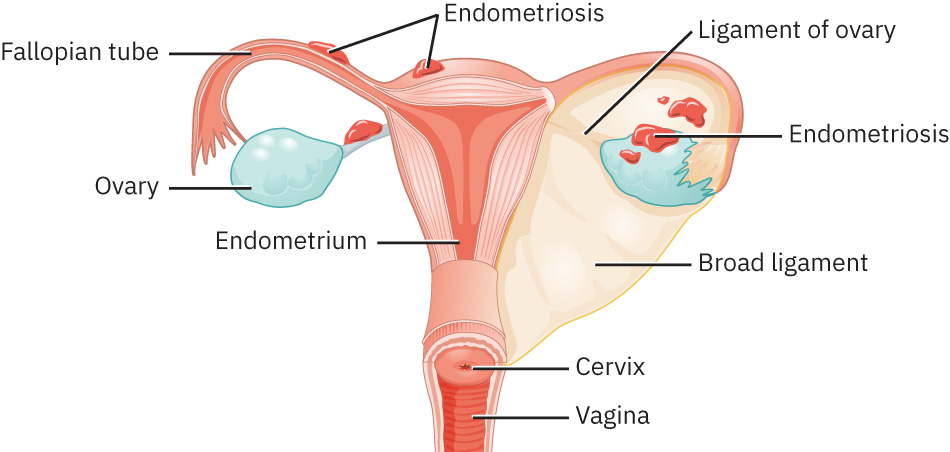18.10 Endometriosis
Endometriosis is a disease in which tissue similar to the lining of the uterus grows outside the uterus, causing inflammation and scar tissue to form in the pelvic region, such as on the ovaries, Fallopian tubes, bladder, colon, and peritoneal lining. See Figure 18.8[1] for an illustration of endometriosis. Endometriosis can start as early as a female’s first menstrual period and last until menopause. The cause of endometriosis is unknown, although researchers are investigating factors such as retrograde menstrual flow, genetic factors, and hormonal or immune system abnormalities.[2],[3]

Symptoms of endometriosis include pelvic pain, dysmenorrhea, heavy menstrual bleeding, dyspareunia (painful sexual intercourse), and infertility. Pain may vary in intensity and duration, often worsening during menstruation. If implants are on the bowel or bladder, gastrointestinal and urinary symptoms may also occur, such as diarrhea, bloating, constipation, painful bowel movements during menstruation, or dysuria.[4],[5]
Diagnostic testing, such as pelvic ultrasound and magnetic resonance imaging (MRI), may be used to visualize abnormalities of the pelvic anatomy. Laparoscopic surgery with direct visualization and biopsy of endometrial implants remain the gold standard for definitive diagnosis.[6],[7]
Treatment of endometriosis focuses on alleviating pain, improving quality of life, and addressing fertility concerns. Pharmacologic options include NSAIDs for pain relief, hormonal therapies such as oral contraceptives and progestins, and gonadotropin-releasing hormone (GnRH) agonists to suppress endometrial growth. If medical treatments are not effective, laparoscopic surgery may be performed to remove endometriotic lesions and improve fertility. In many cases, the discomfort associated with endometriosis resolves during menopause, when estrogen levels decline and the endometrial lining shrinks.[8],[9]
Some women report complementary therapies help relieve symptoms, such as acupuncture; chiropractic care; herbs like cinnamon twig or licorice root; or supplements like thiamine (vitamin B1), magnesium, or omega-3 fatty acids.[10]
Nurses provide health teaching on treatment options, medication management, and self-care strategies. They also suggest positive coping strategies and support groups for coping with chronic pain.[11]
- “301173f03e1a3f42940dbe860daca23c1bbee751” by Rice University/Open Stax is licensed under CC BY 4.0. https://openstax.org/books/maternal-newborn-nursing/pages/6-1-functional-disorders ↵
- World Health Organization. (2023). Endometriosis. https://www.who.int/news-room/fact-sheets/detail/endometriosis#:~:text=Overview,been%20found%20outside%20the%20pelvis ↵
- Office on Women’s Health. (2021). Endometriosis. https://womenshealth.gov/a-z-topics/endometriosis ↵
- World Health Organization. (2023). Endometriosis. https://www.who.int/news-room/fact-sheets/detail/endometriosis#:~:text=Overview,been%20found%20outside%20the%20pelvis ↵
- Office on Women’s Health. (2021). Endometriosis. https://womenshealth.gov/a-z-topics/endometriosis ↵
- World Health Organization. (2023). Endometriosis. https://www.who.int/news-room/fact-sheets/detail/endometriosis#:~:text=Overview,been%20found%20outside%20the%20pelvis ↵
- Office on Women’s Health. (2021). Endometriosis. https://womenshealth.gov/a-z-topics/endometriosis ↵
- World Health Organization. (2023). Endometriosis. https://www.who.int/news-room/fact-sheets/detail/endometriosis#:~:text=Overview,been%20found%20outside%20the%20pelvis ↵
- Office on Women’s Health. (2021). Endometriosis. https://womenshealth.gov/a-z-topics/endometriosis ↵
- Office on Women’s Health. (2021). Endometriosis. https://womenshealth.gov/a-z-topics/endometriosis ↵
- Giles, A., Prusinski, R., & Wallace, L. (2024). Maternal-newborn nursing. OpenStax. https://openstax.org/books/maternal-newborn-nursing/pages/1-introduction ↵
A chronic condition in which tissue similar to the lining of the uterus (endometrium) grows outside the uterus, often on the ovaries, fallopian tubes, or other pelvic organs. This can cause pain, inflammation, and infertility.
Pain during sexual intercourse, which can have physical or psychological causes.

